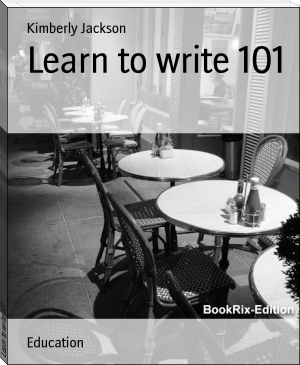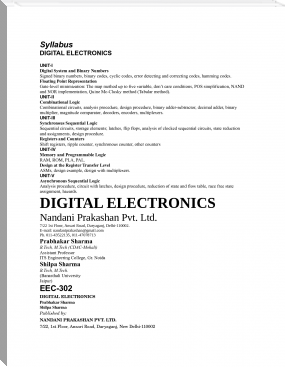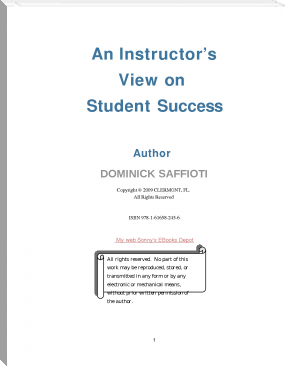Learn to write 101 by Kimberly Jackson (free e novels TXT) 📖

- Author: Kimberly Jackson
Book online «Learn to write 101 by Kimberly Jackson (free e novels TXT) 📖». Author Kimberly Jackson
Michael Leddy teaches college English and blogs at Orange Crate Art.
Comma (,)
1. Use commas to separate items in a series.
Example: Our itinerary included Rome, London, and Madrid.
2. Use a comma before and, but, or, nor, for, so, and yet, when they join independent clauses (unless the clauses are short).
Example: The story gets off to a slow start, but it gets exciting toward the end.
3. Use commas to set off nonessential clauses and phrases.
Example: My father, who started this company, really knows his stuff.
4. Use a comma after introductory elements.
Examples: Well, how do you do?
Before you leave, turn off the lights.
5. Use commas to set off an expression that interrupts a sentence.
Examples: The article in The Herald, our local paper, is about writing skills. Cabs in New York, I'm certain, obey the speed limit.
6. Use a comma in certain conventional situations (to separate items in dates and addresses, after the salutation and closing of a letter, and after a name followed by a title).
Examples: January 1, 1992
New York, NY
Dear Shirley,
Cordially,
Albert Schweitzer, Ph.D.
Don't use unnecessary commas. Use them sparingly and only to clarify issues. Commas in the wrong places can be confusing.
Apostrophe (')
1. To form the possessive case of a singular noun, add an apostrophe and an s.
Examples: Bob's car; One's home.
If the addition of an "s" produces an awkward sound, add only the apostrophe. Usually, this is when there is already a double "s" sound.
Examples: Moses'; for old times' sake; for goodness' sake.
2. To form the possessive case of a plural noun, add an apostrophe after the s.
Example: girls' teams.
If the plural form of the word does not end in s, add an apostrophe and an s.
Example: women's team.
3. Use an apostrophe to show where letters have been omitted in a contraction.
Examples: can't = cannot; it's = it is.
Semicolon (;)
1. Use a semicolon between independent clauses not joined by and, but, nor, for, yet, and so.
Example: Read what you've written; don't just pass it on.
2. Use a semicolon between independent clauses joined by such words as for example, besides, nevertheless, etc.
Example: I think he's right; however, it's difficult to know.
3. Use a semicolon between items in a series if the items contain commas.
Example: Winners in the competition were Bill, first place; Amy, second place; and Jeff, third place.
Colon (:)
1. Use a colon to mean "note what follows."
Example: When you go to training, take these items: paper, pencil, and an alert mind.
2. Use a colon before a long, formal statement or quotation.
Example: We remember Lincoln's Gettysburg Address: Four score and seven years ago....
Hyphen (-)
1. Use a hyphen to divide a word at the end of a line.
Example: If you are not sure where to hyphen-
ate a word, look it up in the dictionary.
2. Hyphenate a compound adjective when it precedes the word it modifies.
Examples: fast-moving train, long-distance runner.
Dash (--)
1. Use a dash to indicate an abrupt break in thought.
Example: The truth is--and you probably know it--we can't do without you.
2. Use a dash to mean namely, in other words, or that is before an explanation.
Example: It was a close call--if he had been in a worse mood, I don't think I'd still be here.
Quotation Marks (" ")
1. Put periods and commas inside quotes.
2. Put colons and semicolons outside quotes.
3. Vary placement of exclamation and question marks according to meaning.
While there are no hard and fast rules about punctuation, there are good style guidelines. This is a list of our ten most commonly used punctuation marks and a guide to their use.
10. Comma
Use commas to separate independent clauses in a sentence, for example:
The game was over, but the crowd refused to leave.
Yesterday was her brother’s birthday, so she took him out to dinner.
Use commas after introductory words, phrases, or clauses that come before the main clause:
While I was eating, the cat scratched at the door.
If you are ill, you ought to see a doctor.
NOTE: You should not do the reverse of this. For example, the following two cases are wrong:
The cat scratched at the door, while I was eating.
You ought to see a doctor, if you are ill.
Introductory words that should be followed by a comma are: yes, however, and well. For example: Yes, you can come to the party
Use a pair of commas to separate an aside from the main body of the sentence. For example:
John and Inga, the couple from next door, are coming for dinner tonight.
You can test this by removing the aside from the sentence. If the sentence still reads correctly, you have probably used the commas as you should. In the case above, this would render: John and Inga are coming for dinner tonight.
Do not use commas to separate essential elements of the sentence. For example:
Students who cheat only harm themselves.
The baby wearing a yellow jumpsuit is my niece.
The Oxford Comma
I prefer the Oxford comma when dealing with lists. It is also known as the Serial Comma or the Harvard Comma. The Oxford comma is much more widespread in American English than British English. When using the Oxford comma, all items in a list of three or more items are separated. For example:
I love apples, pears, and oranges.
Note the comma after “pears”. Many people prefer not to use this style and will omit the final comma. We call this the Oxford comma because it is the standard method taught at Oxford University.
Use commas to set off all geographical names, items in dates (except the month and day), addresses (except the street number and name), and titles in names.
Birmingham, Alabama, gets its name from Birmingham, England.
July 22, 1959, was a momentous day in his life.
Occasionally, you will see a comma between a house number and street. This is not wrong, it is just old fashioned. It is not done in modern times, however.
Use a comma to shift between the main discourse and a quotation.
John said without emotion, “I’ll see you tomorrow.”
“I was able,” she answered, “to complete the assignment.”
Use commas if they prevent confusion:
To George, Harrison had been a sort of idol.
9. Period or Full Stop
The primary use of a period is to end a sentence. Its second important use is for abbreviations. There are stylistic differences here. I will discuss both.
Fowler
Martin Fowler, author of Modern English Usage, says that we should place a period at the end of an abbreviation only when the final letter of the abbreviation is not the final letter of the expanded word. For example:
Jesus Christ was born c. 4-6AD
The abbreviation is for the word “circa” – as it ends in an ‘a’ and the abbreviation is normally ‘c’ – we include the period.
Mr Jones was happy to see his wife
St Patrick lived in Ireland
In the first case above, “Mr” is an abbreviation for mister. Because mister ends in an ‘r’ and the abbreviation includes that ‘r’, we omit the period.
Other
The other use of the period for abbreviations is to always include the period, regardless of whether the final letter is included.
Mr. Jones was happy to see his wife
If an abbreviated phrase is pronounced, we do not include periods. For example: NASA is correct, N.A.S.A is incorrect. In some cases the periods are omitted even when the word is not pronounced, usually because it is a very commonly known term. For example: UCLA (University of California, Los Angeles).
In the case of a word like et cetera (etc.,) we always include the period.
8. Question Mark
The question mark is a fairly easy punctuation mark to use. It has one use, and one use alone. It goes at the end of a sentence which is a question. For example:
How many will be at the party?
you do not include a period when using a question mark. You also do not use a combination of question marks and exclamation marks in formal writing, though this is gaining acceptance in informal writing – particularly on the internet.
One thing to be careful of is to not include a question mark when it is not needed:
WRONG: I wonder how many people will come to the party?
While you are expressing a thought that seems to require an answer, you are doing so with a statement. This is the most common mistake made when using a question mark.
7. Exclamation Mark
Only use this when issuing a command or speaking forcefully! As in the case of the question mark, do not follow this with a period and do not combine it with other punctuation marks. Oh, and only one is needed. Two or three exclamation marks in a row is completely unnecessary.
6. Quote Marks
Quotation marks are used to quote another person’s words exactly, whether they be spoken, or written. For example:
John said, “We are going shopping.” – note the capitalization of “We”. You should do this unless you are quoting in a run-on sentence:
John said “we are going shopping” because they had no milk. Note the omission of the comma in this case also.
If you are quoting a person who is quoting another person, use a single quotation mark like this:
John said, “My neighbor yelled at me today! He said ‘get off my lawn!’”
When introducing a quotation after an independent clause, use a colon and not a comma to begin:
As D. H. Nachas explains, “The gestures used for greeting others differ greatly from one culture to another.” (not an independent clause)
D. H. Nachas explains cultural differences in greeting customs: “Touching is not a universal sign of greeting. (this is an independent clause)
Quotation marks can also be used to denote irony or sarcasm, or to note something unusual about it:
The great march of “progress” has left millions impoverished and hungry.
Punctuation with quotations
Punctuation that belongs to the original quote should be inside the quote marks. Punctuation relating to the entire sentence should be outside.
Philip asked, “Do you need this book?”
Does Dr. Lim always say to her students, “You must work harder”?
Always put colons and semicolons outside quotes. Put commas and periods inside quotations unless followed by parenthesis:
He said, “I may forget your name, but I never remember a face.”
Mullen, criticizing the apparent inaction, writes, “Donahue’s policy was to do nothing” (27).
5. Colon
A colon should be used after a complete statement in order to introduce one or more directly related ideas, such as a series of directions, a list, or a quotation or other comment illustrating or explaining the statement. For example:
The daily newspaper contains four sections: news, sports, entertainment, and classified ads.
The strategies of corporatist industrial unionism have proven ineffective: compromises and concessions have left labor in a weakened position in the new “flexible” economy.
The colon is also used to separate chapter and verse from the bible (I Parlipomenon 12:30), to separate hours, minutes, and seconds: 13:49:08, and as eyeballs in smiley faces.
4. Semicolon
Use a semicolon to join related independent clauses in compound sentences. For example:
Jim worked hard to earn his degree; consequently, he was certain to achieve a distinction.
Jane overslept by three hours; she was going to be late for work again.
The semicolon is also used to separate items in a series if the elements of the series already include commas. For example:
Members of the band include Harold Rostein, clarinetist; Tony Aluppo, tuba player; and Lee Jefferson, trumpeter.
3.
 The desire to acquire knowledge about the surrounding world and human society is quite natural and understandable for a person. Life is so developed that an uneducated person will never occupy a high position in any field. Humanity in its mass, and each person individually, develops objectively, regardless of certain life circumstances and obstacles, but with different intensity. The speed of development depends on the quality of training.
The desire to acquire knowledge about the surrounding world and human society is quite natural and understandable for a person. Life is so developed that an uneducated person will never occupy a high position in any field. Humanity in its mass, and each person individually, develops objectively, regardless of certain life circumstances and obstacles, but with different intensity. The speed of development depends on the quality of training.




Comments (0)